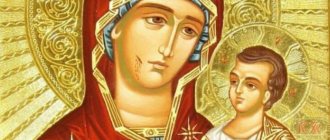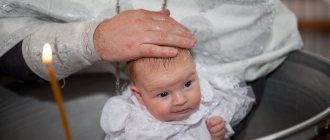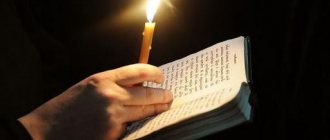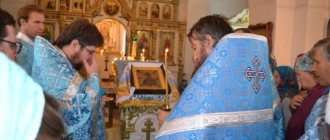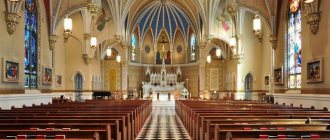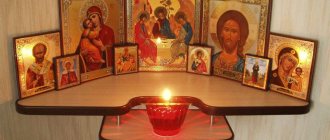Now popular is the spread of so-called ecumenism, that is, the desire to unite all Christian denominations into a single faith. In general, the concept looks quite appropriate and useful, but if you pay attention to some fundamental differences between the branches of Christianity, the difficulty of such a unification becomes clear. Take, for example, Catholic icons in comparison with Orthodox ones; almost every detail here speaks of a fundamental and significant difference between the traditions. Also, these differences allow us to better understand how these schools of Christianity differ.
How do Catholics pray?
Catholics are accustomed to praying to a mental image of God or saints; for this they do not need icons. In Catholicism, you can pray while sitting. The most important thing is to think about the meaning of the words of the prayer.
For Catholic icons there are no strict canons that regulate their creation. The painting of religious paintings is largely dictated by the imagination of the artists. The details of the picture (clothing of the saints, facial features), which can distract from prayer, are clearly stated. This is the main reason why Catholics do not say prayers in front of icons.
Interesting Facts
The most revered are the Catholic icons of the Mother of God, which are distinguished by their special artistic expressiveness. On them, the Virgin Mary appears as a young and innocent, sophisticated girl. Facial expressions can include a variety of different fleeting emotions.
Common are Catholic icons of the Virgin Mary like the Immaculate Heart, where the composition is complemented by symbols such as the heart of the Mother of God on top of her robes. Such symbols are thought-provoking and evoke emotions. In some ways they are even edifying.
For example, the Catholic icon of the Virgin Mary and Child not only awakens a prayerful mood and desire for the divine, but also many additional thoughts, including very “earthly” ones: about the beauty of the world, about the miracle of maternal relationships. This is one of the main differences between Orthodox and Catholic icons.
( 1 ratings, average: 5.00 out of 5)
The semantic difference between Orthodox and Catholic icons
Orthodox icon painters were strongly influenced by the Byzantine iconographic school, which took much from the Hellenic and Persian schools of art. Orthodox iconography is strict, monumental, spare in line, ascetic and full of a lot of smooth movements. All objects are stylized as much as possible, simplified to the level of symbols. Orthodox images of Saints are solemn and filled with the light of heaven. The Orthodox icon was created for only one purpose - prayer. An Orthodox icon encourages a person to pray to the Lord, makes him renounce the vanity of the world.
At first, the shrines in Catholicism practically did not stand out against the background of other shrines in Orthodoxy. But over time, they became more rich, lively and overgrown with details. They became more a creative reinterpretation of a story from the Bible than objects of worship or cult. For Catholics, an icon is not an image of a Saint, carrying a sacred meaning and evoking awe, but rather an object of fine art demonstrating a specific episode from the Holy Letter or church traditions. The basis of the Catholic image is a story, a narrative direction in order to convey something to the beholder, to convey some idea depicted in the picture.
In contrast, the Orthodox icon does not teach anything and does not tell a story. Due to the complexity and multifaceted structure, each person praying will find his own meaning in it for himself. These icons require additional knowledge from the beholder for correct interpretation, and even then the image can be interpreted on several levels, from the episode it depicts to the sacred meaning revealed during prayer. The main thing is the process of prayer and the actions that encourage it.
The difference between Catholic and Orthodox traditions of icon painting (iconography)
What distinguishes an Orthodox icon from a Catholic one is the canon.
- The canon in icon painting is an unchanging or, even more likely, (conservative) traditional set of laws, forms and rules that are not subject to revision. These laws were formed over the centuries, were often unspoken and were not transmitted in writing, but had to be approved by the Church.
The canon in Orthodoxy does not allow deviations. The permissible maximum is changes in the color spectrum, depending on the school of icon painting, on the specific Saint, and on the idea put into the icon. For example, the Virgin Mary is always depicted wearing a scarlet or purple scarf, with three stars on it, and a blue robe. This rule is true for Nicholas the Ugodnik, and for Luke of Crimea, and for Panteleimon the Healer, who have their own canons.
An Orthodox icon painter cannot allow himself to be subjective, to fantasize too much when painting a shrine, unlike Catholic icon painters, in whose case the manifestation of artistic talents is not only not prohibited, but is even encouraged.
- Inscription. In the inscription of the icons of the Blessed Virgin, four letters of the Greek alphabet are used: MR - MF, which means “Mary Mother of God”. There must be an inscription in every icon of the Mother of God, for without it the icon cannot be considered an icon. The same is true for other icons of Saints. In the Orthodox tradition, contractures (abbreviated names or phrases on images) are written in either Church Slavonic or Greek, while the ritual language of Catholics is Latin.
- Nimbus. Another obligatory element, the light from which personifies the inner spiritual light of the Saint and seems to emanate from his head. At the same time, in Catholic iconography, the halo is depicted above the head of the Saints in the form of a hoop, sometimes combined with a crown of thorns. In some cases, the halo can be replaced by a Catholic element - a crown, which came from the West and the territory of modern Ukraine.
- Face of the Saint. An Orthodox icon never seeks to depict the Saint as they do in painting, nor does it attempt to convey an accurate image of the Saint during his lifetime. Only the main features are drawn: beards, books, tools used in life, etc. The most important part is not so much the appearance of the Saint during life, but his appearance inherent in him in the Heavenly Kingdom.
- Volume and time. Orthodox icons are two-dimensional, they have no volume. Even if the action takes place indoors, it is depicted schematically and without elements that give the picture depth, such as windows behind which a certain landscape could be seen.
- Shadows. Orthodox images do not have shadows, since the icon conveys how the Saint should look in Heaven. Each such detail is not a figment of the icon painter’s imagination, but rather aspirations subordinated to the idea of embodying an image from Eternity (the Other World), inaccessible to mere mortals.
- Perspective. The Orthodox icon uses a reverse perspective, while the Catholic icon uses a forward perspective. With direct perspective, objects are depicted as we are accustomed to seeing them in reality, i.e. decrease with distance, while in the opposite direction - vice versa.
- Hand gesture. Among Orthodox icon painters, it is customary to depict the right hand on top of the left, thereby this gesture personifies victory over the flesh, which is sinful.
Icons in Catholicism are directly opposite to Orthodox ones. A Catholic shrine is, first of all, an object of art, the final embodiment of which depends entirely on the talent and flight of thought of the artist. At the same time, it is almost always possible to find out the exact name of the author, while the creators of Orthodox icons are most often anonymous and different people work at different stages of creating icons.
In the case of ancient icon painters, the most important parts, such as the face and eyes (personal writing), were painted by one icon painter, whereas before copying, “personal” work was done by a student or journeyman. In our icon-painting workshop, some people work on the image, others do the stone processing, and still others do the painting. If we talk about large-scale work, then the number of people involved increases in proportion to the volume of work.
In Orthodox icon painting it is possible to recognize a school or tradition, for example, the icons of Dionysius or Simon Ushakov, but this is closer in meaning to a peculiar turn of phrase. It would be more correct to talk about specific schools of icon painters, for example, the school of Theophanes the Greek or the school of Dionysius, rather than assert that the author is a specific founder of the school.
In the works of Catholic icon painters you can always see the play of chiaroscuro. Various small details, movements and poses look ordinary, despite their aesthetic appeal. They look like sketches from the everyday life of ancient people, like a plot that can be seen in the earthly world, but not in the spiritual world. This was one of the reasons why in Protestantism there is no veneration of icons in the form in which it is characteristic of the rest of the Christian world.
